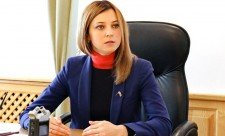Today the “prosecutor” of Crimea Natalya Poklonskaya sent the crime investigators of the peninsula 6 materials for initiation of criminal cases for extremism under the Criminal Code of the Russian Federation.
At the same time, the Ukrainian Institute of Research of Extremism presents the research results for 2014, according to which Crimea was in a group with an alarming level of extremism – the second one after the area of combat operations. However, the definition of extremism in Russia and Ukraine as well as the understanding of “human rights” is very different.
On the other side…
Thus, in the Russian Federation you can be convicted of public appeals to the violation of integrity of the territory of the Russian Federation (Part 2, Article 280.1 of the Criminal Code of the Russian Federation), establishing organizations offending the personality and rights of the citizens (Part 2, Article 239), incitement of hatred or enmity (Part 2, Article 282), the financing of extremists (Article 282.3), organizing mass riots (Part 2, Article 212) and even just keeping the extremist literature (more than 2.5 thousand of items of which has been counted in Russia since 2007). However, apart from the criminal code, there is also such an interpretation, according to which it is possible to define anything as extremism – depending on imagination of a crime investigator or a prosecutor. For example, the Ukrainian flag on the building of the Mejlis as it happened last April.
Today the “prosecutor” of Crimea Natalya Poklonskaya presented the results of the last year’s report that says that about 7 thousand cases of extremism were registered on the territory of the “republic”.
“In 2014 more than 1.7 thousand law violation cases were found out, 356 recommendations were made, according to examination of which, criminal proceedings were instituted against 298 persons in the course of supervision over execution of legislation on federal security, ethnic relations and countering extremism. Four criminal proceedings were instituted based on the prosecutor’s inspections. As part of the prevention work, 81 persons were warned about inadmissibility of violating the law, 3 warnings were issued,” the report of the public prosecutor’s office of Crimea said.
On this side
It should be said that generally speaking, there is no term of extremism and punishment for that in the legislation of Ukraine. There are certain legislative acts such as, for example, the Law against xenophobia that strengthened responsibility under the Art. 115, 121, 122, 126, 127, 129, 161 and 300 of the Criminal Code of Ukraine. There were several attempts to adopt draft laws on a ban of extremist activities since 2011. Last time extremism on the legislative level was discussed on January 16 last year, when the deputies in the parliament voted by hand for the law against Maidan.
However, if speaking about extremism in Crimea today, the Institute of Research of Extremism means, first and foremost, xenophobia, inter-confessional conflicts, political extremism and illegal seizures (as economic extremism).
One hundred twenty cases of such nature were registered in Crimea and 55 of them – in March. But experts of the Institute of Research of Extremism emphasize that the extremism level remained one of the highest on the territory of Ukraine after annexation.
Undoubtedly, such a difference in figures with the Russian numbers is based on the larger number of articles against extremism in the Criminal Code of the Russian Federation and their varied interpretation. In particular, a large number of so called extremists is the citizens, who keep various literature, which is in the prohibited list, at home. Particularly, it may be the Islamic religious books, which are not censured according to the Ukrainian legislation at all (as any other books).
Legalization of extremism after the annexation
“Even if we don’t count the March figures, which are high enough as they are, then a number of extremist cases in Crimea is significantly higher than extremist cases in Kherson, Nikolaev and even frontline Zaporozhye regions. First of all, these cases demonstrate the worsening of relations between the occupation authority and pro-Ukrainian activists,” the representative of the Institute of Research of Extremism Bogdan Petrenko said.
In particular, the Crimean Tatar activists have recorded more than one case of kidnapping of the Crimean Tatars and pro-Ukrainian citizens, and Ukrainian news agencies – illegal seizures of business owned by Ukrainian and foreign businessmen.
The high level of extremism helps to increase human rights violations. Thus, the international human rights organization “Human Rights Watch” presented its annual report on observance of human rights in the world, in which the authors admitted that the main European problem today is Ukraine and Russia. According to the information of the organization, a number of basic human rights are violated on the peninsula. So, public criticism of the Russian authorities is stopped, the right to freedom of thought and speech is violated, any protest activity is prohibited, actually, people are imposed the Russian citizenship. First of all, it comes to the pro-Ukrainian activists and Crimean Tatars but now it starts to come to those people, who simply express their dissatisfaction openly. Since Ukraine doesn’t have any possibility to influence the situation on the peninsula after the annexation, the responsibility for all these human rights violations lies on the occupation authorities.













